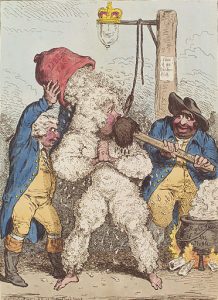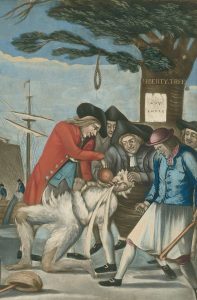 I think most of us have heard of being “tarred and feathered,” as a form of punishment, but we may not really know how much of a punishment it really was. When we think about it, the show, “Home Alone” might come to mind. Of course, some kind of syrup and then the feathers, but that does not really even begin to describe the real act of tarring and feathering.
I think most of us have heard of being “tarred and feathered,” as a form of punishment, but we may not really know how much of a punishment it really was. When we think about it, the show, “Home Alone” might come to mind. Of course, some kind of syrup and then the feathers, but that does not really even begin to describe the real act of tarring and feathering.
In 1776 in Norfolk, Virginia, Captain William Smith was tarred and feathered by a mob which actually included the mayor of Norfolk apparently!! Mobs are never a good thing. They are always out of control, and people who might normally be pretty decent, are dragged into things they might never do otherwise. Captain Smith was suspected of sharing secrets about a local ship owner John Gilcrest smuggling goods, with British officials. It was a terrible offence, but remember that he was “suspected” of this, not convicted. That is the problem with the mobs. They often take matters into their own hands…Vigilante Justice…whether the person is really guilty or not.
Tar and Feather was a medieval form of torture and humiliation. It involved stripping the victim up to his waist, applying tar on his body, and covering him with feathers. That wasn’t the end of it though. The victim was then put on a cart and paraded around the place. Sometimes, the tar was simply poured on the victim’s body and he was made to roll on feathers. This isn’t like syrup or the asphalt tar of today. The tar they used was likely from the pine tar the Colonies were accustomed to distilling for its use on preserving the wood of ships from rot. Hot asphalt tar would critically burn the body. Pine creates charcoal and pine tar when heated up. This pine tar is naturally a sticky substance making it a perfect material for applying to someone who is about to be covered in  feathers. While that explains why there were no casualties of this form of punishment. Nevertheless, the job of removing the dried pine tar and feathers off the skin was extremely painful.
feathers. While that explains why there were no casualties of this form of punishment. Nevertheless, the job of removing the dried pine tar and feathers off the skin was extremely painful.
After Captain Smith was humiliated by the application of his feathery outfit, he was thrown into the harbor. He almost drowned before being rescued by a passing ship, just as his strength was giving out. He survived, and was later quoted as saying that “…[they] dawbed my body and face all over with tar and afterwards threw feathers on me.” As with most other tar and feathers victims in the decade that followed, Smith was suspected of informing on smugglers to the British Customs service. The punishment was harsh, and it was swift. The colonies were trying to gain their freedom, and that meant that they would fight to the death, and they would never tolerate traitors. I don’t know if Captain Smith was a traitor or not, but no one was ever punished for what they did to him, so there is that.


Leave a Reply